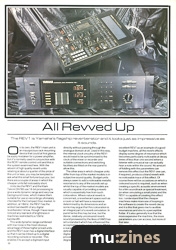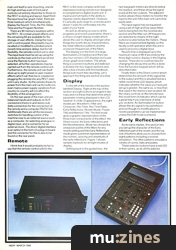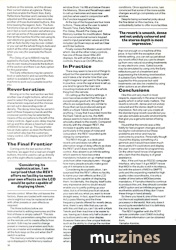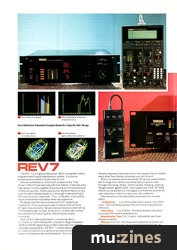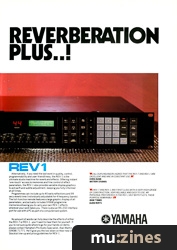Magazine Archive
Home -> Magazines -> Issues -> Articles in this issue -> View
All Revved Up | |
Article from Home & Studio Recording, March 1986 | |
The Yamaha REV1, possibly the most sophisticated digital reverb on the market.
The REV1 is Yamaha's flagship reverberator and it looks just as impressive as it sounds.

On its own, the REV1 main unit is an inauspicious rack mounting device that could at first glance be easily mistaken for a power amplifier, but it's normally used in conjunction with the RCR1 remote control unit and this is the system examined here. With the advent of high quality reverb units retailing at about a quarter of the price of this unit or less, you may be tempted to ask what this small fortune buys you, but there are a couple of areas in which the cheaper units fall noticeably short.
Units like the REV1 and the Klark Teknik DN780 use 16-bit processing to give a wide dynamic range and very low background noise, which makes them suitable for use on recordings ultimately intended for the Compact Disc market. In addition, at 18kHz, the REV1 has the widest bandwidth of any digital reverberator I know, though I have never noticed any real lack of brightness in machines restricted to a 12kHz bandwidth.
This wide dynamic range combined with low noise is the most obvious advantage of these higher priced units and the REV1 even has a digital interface so that it can be linked up to a digital recording console or recorder. This enables it to accept a digitised input directly without passing through the analogue domain at all. Used in this way, the internal clock circuitry of the REV1 would need to be synchronised to the clock of the mixer or recorder and suitable connections and switching facilities are fitted on the rear panel to allow this.
The other area in which cheaper units differ from top of the market models is in subjective sound quality. Budget units always seem to add a noticeable metallic resonance to any of the sounds set up whilst the top of the market models are usually capable of providing a reverb which is essentially free from such colouration. Where natural reverb is concerned, a reverberant space such as a room or hall will have a resonance determined by its dimensions and so some may argue that this colouration is an integral part of a reverb simulation. In purist terms this may be true, but the dense, relatively uncoloured reverb sound pioneered by the likes of AMS has set a standard which has influenced the accepted sound to a large extent. Whilst a real plate reverb device may have a definite and fixed metallic colouration, a digital machine is expected to be able to provide a plate simulation with various degrees of colouration. Using the excellent REV7 as an example of a good budget machine, all the reverb effects display some degree of resonance which becomes particularly noticeable at decay times of less than one second where a listener with a musical ear can actually hear a note within the sound. No amount of fiddling with the parameters can remove this effect but the REV1 one can, if required, produce a bland reverb with no noticeable trace of this effect. Of course there will be occasions on which a coloured sound is required, such as when creating a specific acoustic environment for a film soundtrack or special treatment, (or when simulating a small plate) and the REV1 is capable of creating this effect too. I understand that the cheaper machines make more use of looping in the software to create the reverb decay and it is this that gives rise to audible resonances and also to a perceptible flutter. It's also generally true that the more expensive the machine, the more parameters you can access, but more of that later.
The REV1 Package
The RCR1 is connected to the main unit by means of an umbilical multicore that terminates in small lockable delta connectors. Weighing in at 10kg, the main unit itself is rack mounting, stands 4U high and has a set of front panel controls not entirely dissimilar to those on the REV7 in styling and layout. Apart from the input level bar graph meter, there are three readouts which simultaneously display the Reverb Time, the Pre-Delay Time and the Program Number.
There are 90 memory locations within the REV1, 30 contain preset effects and the remaining 60 are available for the storage of user effects. Using the main unit's control panel, the presets may be recalled or modified to a limited extent (reverb time and pre-delay), but for full flexibility, the remote control unit is vital. The input level must be set up using the controls on the main unit front panel but once the Remote button has been selected, all further operations may be carried out from the remote control unit. Furthermore, the remote unit can itself store up to eight preset or user created effects which can then be re-created on plugging the remote into any REV1 main unit in any studio. As the remote draws its power from the main unit via its multicore, even mains power supply variations from country to country will not affect the flexibility of this arrangement.
On the rear panel of the main unit are balanced inputs and outputs on XLR connectors (mono in and stereo out), delta connectors for the connection of the remote and a computer RS232 link. Additionally there are all the necessary switches for handling control of the machine over to an external source such as a computer, for selecting analogue or digital input, and a connector for an external clock. The direct digital interface is an option in the form of a plug-in board and the connector for this is also to be found on the rear panel.
Remote

I think that it would probably be fair to say that the remote control unit for the REV1 is the most complex and most impressive looking remote ever designed to complement a digital reverb unit. It must score full marks in the ability to impress clients department. However, it's actually quite large for a remote and it doesn't really fit comfortably into the palm of your hand.
As well as allowing access to all the programs and reverb parameters, there's a choice of eight display modes which allows the user to display amongst other things the reverb decay characteristics, the initial reflection patterns and the crossover frequencies of the filters.
The display is in the form of a large, illuminated LCD readout and there are also four numeric LED displays and a pair of bar-graph level meters. The whole thing is covered in buttons and dials but is divided into four logical sections and, after a few minutes with the handbook, things look much less daunting. Let's approach the thing one section at a time.
Display
To the left of the remote is the section labelled Display. Right at the top of this section are eight buttons arranged in two rows and it is these that determine which parameter is being displayed in the LCD readout. In order of appearance, the eight modes are: Waveform, Filter and Crossover, Rev Time, Rev Time Ratio, Early Reflections, Reverb Mode, Preset Title and Memory Title. The first mode gives a graphic representation of the three main components of the effect: the Direct sound, the Early reflections and the Reverberation. Mode two shows the crossover points of the filters for any reverb setting and the Early Reflections mode gives a pictorial representation of the number, spacing and amplitude of the early reflections. Figure 1 shows sample readouts for all eight modes of display.
Getting back to the guided tour, the twin bargraph meters are directly below the readout, and these show the signal levels at the two outputs. The adjacent button allows these meters to monitor the input to the unit if the main unit cannot be easily seen.
"Considering its sophistication, I am surprised that the REV1 offers no facility to name your own effects as the LCD would be quite capable of displaying them."
The input signal may be equalised using a set of high and low-pass filters before being fed into the reverberator section and the filter cut-off frequencies are selected by means of the eight buttons located below the meters. These filters are implemented digitally so this facility is still operative when the unit is used to process a digital input.
Reverb time is displayed up to the maximum value of 99.9 seconds by the three digit numeric display in the Display section. There are no controls here for changing the decay time as this is done from the function keypad which will be described later.
Finally there is the Direct control which determines the amount of dry signal fed to the output and this is situated below a rather novel three LED display which indicates whether the value you have just set up is greater, the same as, or less than that used in the memory last recalled. All the rotary controls on the remote have this novel form of indicator which can be a great help if you lose track of what you've done. An illuminated On button allows the dry signal to be switched in and out though no modifications to reverb parameters can be implemented unless the Edit mode is entered.
Early Reflections
As its name implies, this section lets you set up the character of the Early reflection part of the reverb and the top row of buttons allow you to choose from eight patterns including a reverse simulation. The other patterns simulate a variety of rooms, halls and plates.
These selector buttons have a red LED in their centre, as do all the selector buttons on the remote, and this shows their current status at a glance. Rotary switches enable the Room Size, Early Reflections Number and Liveness to be adjusted and this section also includes another of those illuminated buttons, this time bearing the legend, Auto. The Auto functions crop up in all sorts of areas and are in fact a room simulator aid where you can set up some of the parameters and then let the machine find the rest using its own electronic good taste. Any section with an Auto facility may be over-ridden or you can set the whole thing to Auto and watch all the other parameters change when you vary (for example) the Room Size.
Pre-Delay of up to 600mS may be applied to the Early Reflections and this has its own readout towards the bottom of the section and there's an Auto option for this parameter.
The Early reflections may be varied in level or switched in and out and the Auto option is available if you want the machine to work out a suitable level for you.
Reverberation

Moving on to the next section we find another row of eight buttons, which are used to select the type of reverberation characteristic required and the choices are set out in descending order of density. The decay time may be varied in each of three frequency bands and the crossover points may be selected by means of the six buttons to the left of the rotary controls. Again a pre-delay may be set up and this allows a maximum value of 600mS to be set up. This parameter has an Auto option as does the Reverb Level which also has the customary rotary control, LED display and On/Off button.
The Final Frontier
Coming onto the last section of the machine, we again find a neat set of eight buttons, this time used to call up directly any of the eight effects loaded into the remote control. When the unit leaves the factory, these are loaded with memories one to eight but may be replaced at will with other presets or user effects as required.
The three buttons below are instrumental to editing memories and the first of these is simply called P. This lets you modify parameters using the controls on the remote unit to create effects from scratch. Edit may be used to change preset or memory parameters and Auto acts as a master and enables or disables all the Auto keys on the unit when the P switch is active.
The memory number currently called up is displayed in the Memory readout window (from 1 to 99) and below this are the Memory, Store and Recall keys used to call up memories and save new patches when used in conjunction with the Function keypad below.
"The reverb is smooth, dense and not unduly coloured and the stereo depth is most impressive."
At the top of the Keypad are four more buttons. These allow the user to select Reverb Time, Early Reflections Pre-Delay, Reverb Pre-Delay and Memory number for modification. Below this is a conventional numeric keypad used to input parameter values and this includes Up/Down keys as well as Clear and Enter buttons.
Finally comes the Master Level control which, like all the other rotary controls, has one of those clever little LED displays. As with all the other Level controls, there is an On/Off button.
In Practice
There may seem to be a lot of things to adjust but the operation is pretty logical and it takes a far shorter time than you might imagine to get used to the system. In practice, once the signal level is set up, you tend to ignore the main rack mounting module and drive the whole thing from the remote.
On calling up the factory settings, it soon becomes evident that this is an exceptionally good unit, though the effects are subjectively very similar to those that can be produced using an AMS or a Klark Teknik machine. If anything, I'd say that it sounded more like the Klark Teknik as to me, the AMS always seems to have a distinctive slow whooshy attack to the reverb. Compared directly with the cheaper REV7, the increase in quality was obvious, particularly in the areas of noise and colouration; the REV7 sounded quite clangy by comparison.
The REV1 though, is a dedicated reverb unit and does not offer an alternative range of delay effects as does the REV7 and it does not have MIDI control. Also absent is an Infinite setting which seems to have become a mandatory inclusion on up-market reverb units from other manufacturers — though how many people actually make good use of it remains to be seen.
Considering its sophistication, I am surprised that the REV1 offers no facility to name your own effects as the LCD would be quite capable of displaying them. Incidentally, the display itself looks very impressive and no doubt would enable you to justify putting up your rates, but is of limited practical value as your ears tell you what you want to know straight away. In fact, apart from the extra Hi/Lo pass filtering and the three frequency bands offered for reverb decay time, there's very little that you can do with this unit that you can't do with a Klark Teknik and their machine is far easier to use, having as it does only half a dozen or so buttons and a very clear display. However there are a few unique features such as the ability to change the number of early reflections and add pre-delay to the main body of reverberation separately (as opposed to just the early reflections), but there is only so much detail that the ear can resolve, and that's when you are working under test conditions. Once applied to a mix, I am convinced that some of the more subtle changes would go completely out of the window.
Despite being somewhat picky about the fine detail on this machine, it is undoubtedly better to offer more facilities than not enough on a machine of this price. In fact with the exception of an Infinite setting, you can set up just about any reverb effect that you care to dream up from very natural sounding treatments to very electronic ones. Gated sounds may be simulated by using only the Early reflections part of a treatment and suppressing the following reverberation. A suitable Early Reflections pattern is supplied for this purpose but valid treatments can also be created by using other options as an alternative.
Conclusions
I like this unit very much in most respects, especially in the area of sound quality which is what really matters. The reverb is smooth, dense and not unduly coloured and the stereo depth is most impressive. Not only can you create all the standard pop reverb sounds but you can also simulate acoustic environments that give you a genuine sense of being there.
I found that the remote was a little fiddly for fast program changes and just too big for convenience but these problems are minor and may be overcome by practice. Personally though I found the display something of a gimmick and it would have been much more useful if it could store and display the user's own names for programmes. On the other hand I know of engineers who claim that the display is of great assistance.
Also, if the unit has an RS232 computer interface, why hasn't it got MIDI? I know that MIDI in the studio is still in its infancy, but with the advent of MIDI to SMPTE units and the expanding market for high quality video soundtracks, it is only a matter of time before MIDI becomes mandatory. If Yamaha intend to continue to produce this unit, they should consider a MIDI option and an Infinite program as worthwhile additions if they don't have these things in hand already.
So there you have it; one of the most if not the most sophisticated reverb processor in the world. Not only does it sound quite wonderful but it is definitely the one to be seen with.
The REV1 together with the RCR1 remote controller cost £5900 including VAT.
More information can be obtained from; Yamaha-Kemble, (Contact Details).
Featuring related gear
Interior Designs - Yamaha REV5 Reverb
(SOS Nov 87)
Roland SRV2000 & Yamaha REV7 Reverbs
(12T Feb 86)
Wide Open Spaces
(EMM Sep 85)
Yamaha REV-7 - Studio Test
(IM Oct 85)
Yamaha REV7 - Digital Reverb
(HSR Oct 85)
Browse category: Studio/Rack FX > Yamaha
Publisher: Home & Studio Recording - Music Maker Publications (UK), Future Publishing.
The current copyright owner/s of this content may differ from the originally published copyright notice.
More details on copyright ownership...
Review
Previous article in this issue:
Next article in this issue:
Help Support The Things You Love
mu:zines is the result of thousands of hours of effort, and will require many thousands more going forward to reach our goals of getting all this content online.
If you value this resource, you can support this project - it really helps!
Donations for April 2024
Issues donated this month: 0
New issues that have been donated or scanned for us this month.
Funds donated this month: £7.00
All donations and support are gratefully appreciated - thank you.
Magazines Needed - Can You Help?
Do you have any of these magazine issues?
If so, and you can donate, lend or scan them to help complete our archive, please get in touch via the Contribute page - thanks!
